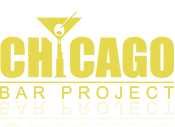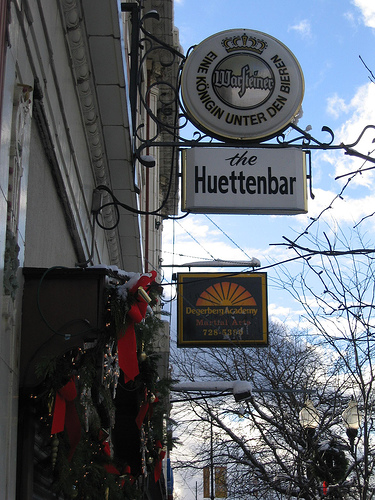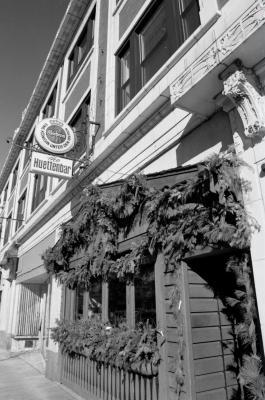While Chicago may be one of the flattest cities on Earth, there’s a place I know of that makes you feel like you’re nestled somewhere amongst the Austrian Alps: Huettenbar. With more wood and warmth than you can shake a ski pole at, the Huettenbar is one of the last surviving Germanic taverns of Lincoln Square, and one of the most authentic. You never know how long places like Huettenbar will last, so your advice from the Chicago Bar Project: pull up a stool at Huettenbar, have yourself a Spaten or Edel-Kirsch, and soak up the atmosphere while you dream of skiing in the Alps.
Huettenbar has been filling steins in the heart of Lincoln Square and across from the legendary Chicago Brauhaus and Merz Apothecary since 1985. There you’ll find a tasteful Warsteiner sign with the bar’s name modestly scripted below it, hanging above a picturesque wooden facade. The triangular roof looks so realistic, you will barely notice the two stories of brick above it. Step through the pair of wooden doors that comprise the entryway and you’ll find the inviting and warm interior of Huettenbar. The front room features a somewhat sloped, wood paneled ceiling and a floor of multicolored ceramic tile in earthy tones. A few cocktail tables are set in front of windows that look out over a section of Lincoln Avenue named Karl Laschet Strasse, the proprietor of Laschett’s a little further south. These windows open out in Summer, below which are placed a nicely arranged flower setting.
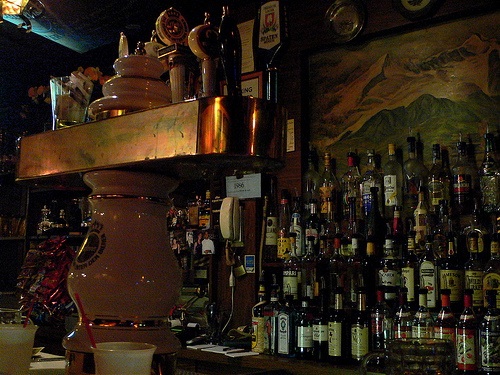 Photo courtesy of pixelatedmonkey
Photo courtesy of pixelatedmonkey
A wooden bar topped with Formica runs most of the length of the northern wall, behind which is a painting of a small hideaway nestled along Alpine slopes that inspired the name “Huettenbar,” loosely translated as “mountain hut/bar” in German. Like Hansa Clipper just down the block, Huettenbar does not serve food, but the only sustenance you’ll need comes from one of the 10 beers on tap like Kutschen Alt and Spaten (more in bottles, all of which are satisfyingly drawn into round beer mugs), as well as from their intriguing selection of German liqueurs, ranging from the herbal Jagermeister, Westfalen Jager, Kabanes, and fruity Edel-Kirsch (cherry), Echte-Kroatzbeere (blackberry), Crazy Ananas (pineapple), and Barenjager (honey). A red metal sign over the front door says, “Jager Strasse,” and they’re not kidding
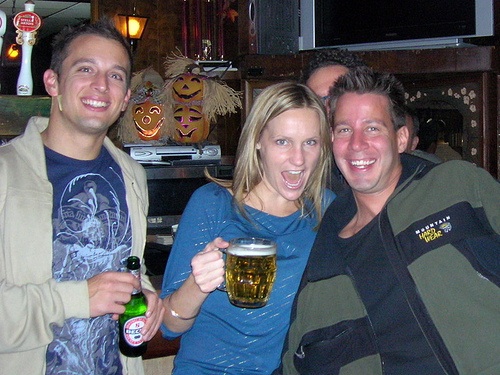 Photo courtesy of heyheyjmayAcross from the bar is an alcove that offers the best seat in the house, above which is a mural depicting an Austrian waitress beckoning you with full mugs of beer. The Fraulein just happens to be the owner, Irma Frolich, who opened the establishment once the previous enterprise, the aforementionedChicago Brauhaus, moved across the street in 1985. According to Mickey Cotter in Barfly’s Guide to Chicago’s Drinking Establishments (2000), “Irma’s mother was a cook at the Bauhaus. When Irma found out that the bar was for sale, she decided to try her hand at the business. Formerly a production artist, she knew little about running a bar. ‘My customers were the ones who taught me how to run my own place,’ she says, with a laugh. ‘I learned the trade day by day. Louie, the bartender, was here before me, and he helped greatly.’ Her relaxed and light-hearted attitude serve to make the place a friendly environment.” A more colorful mural of a more modern street scene can be found on the south wall, next to the alcove and Irma’s mural.
Photo courtesy of heyheyjmayAcross from the bar is an alcove that offers the best seat in the house, above which is a mural depicting an Austrian waitress beckoning you with full mugs of beer. The Fraulein just happens to be the owner, Irma Frolich, who opened the establishment once the previous enterprise, the aforementionedChicago Brauhaus, moved across the street in 1985. According to Mickey Cotter in Barfly’s Guide to Chicago’s Drinking Establishments (2000), “Irma’s mother was a cook at the Bauhaus. When Irma found out that the bar was for sale, she decided to try her hand at the business. Formerly a production artist, she knew little about running a bar. ‘My customers were the ones who taught me how to run my own place,’ she says, with a laugh. ‘I learned the trade day by day. Louie, the bartender, was here before me, and he helped greatly.’ Her relaxed and light-hearted attitude serve to make the place a friendly environment.” A more colorful mural of a more modern street scene can be found on the south wall, next to the alcove and Irma’s mural.
A wooden partition separates the front room from the rear. You’ll find a somewhat smaller bar in the back, above which hangs an interesting light fixture from a white drop-ceiling that looks like someone cut holes into a bucket, wired it for a light bulb and hung it from a thick chain. The Chicago Bar Project wholeheartedly approves of such tavern accoutrements. A few flatpanels quietly provide whatever entertainment deficit is left from the conversation and the tunes from an eclectic jukebox, where anything from Lionel Richie to alternative to traditional German songs can be heard. Elsewhere in the back room, a wood-paneled eastern wall has built-in, walk-up cooler doors, a smattering of tables that provide additional seating, and a short hallway that leads to two smallish restrooms.
“For a quiet evening with friends, or the beginning of an all-night bender where you wake up next to a German Shepherd watching Teletubbies, give the Huettenbar a try.”
– Shecky’s Bar, Club & Lounge Guide 2002Chicago’s Alpine hideaway, known to you now as Huettenbar, is what you would imagine the interior would look like of that painted on the mural behind the bar. The patronage of Huettenbar, once heavily German, has almost entirely been replaced by a younger crowd, just as the neighborhood around it has. However, the old Germans still around, as well as those from every other nationality in this great city, descend upon Huettenbar during the hugely popular Maifest and Oktoberfest neighborhood festivals, celebrated each year in Lincoln Square. If you like Huettenbar, be sure to check out nearby Chicago Brauhaus, Hansa Clipper and Glunz Bavarian Haus, as well as Resi’s Bierstube and Laschet’s Inn a little further south in North Center. For more information, Huettenbar does not have a website, so give them a call at the number listed above. Until next time, tschuss!
